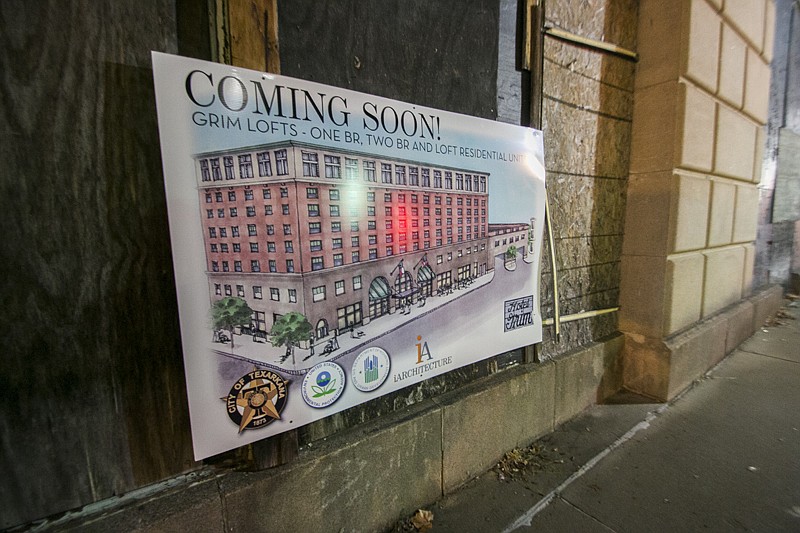Signs posted last week on the Hotel Grim that promise its renovation is "coming soon" may have been premature, depending on the outcome of tax reform negotiations in the U.S. Congress.
House and Senate versions of Republicans' tax legislation differ on whether to eliminate various tax credits, and the Grim's fate could hinge on which choices survive the versions' reconciliation.
At issue are the historic tax credit, which rewards developers for preserving historic structures, and the 4 percent low-income housing tax credit, which incentivizes making new housing affordable to low-income residents. Both are important factors in financing the Grim's renovation, and both would be eliminated by the House's tax-reform bill. The Senate version leaves both intact.
Whether elimination of those programs would affect the Grim project's eligibility for them remains to be seen. Depending on when cuts would take effect, it is possible that the project could be grandfathered and proceed as planned.
"We're kind of in a holding pattern at this point," said David Orr, city director of planning and community development.
The Senate's passage of a tax-reform bill Saturday cast sudden uncertainty on the Grim project, which had been seen as having only a few bureaucratic obstacles in the way of beginning construction.
Attorneys for developer Jim Sari are preparing to close his purchase of the hotel, and Texas housing authorities are putting a final stamp of approval on the project's financing, Orr said.
The federal Department of Housing and Urban Development, which is providing more than $1.4 million in loan guarantees to help finance the project, requested that state authorities sign off on the Grim's funding package. The city has provided all requested documents and the approval process is under way, Orr said.
HUD's Community Development Block Grant Section 108 program is making available five times the city's annual CDBG allocation to lend for development, at low interest rates.
Sari had the new signs posted on the building in anticipation of holiday crowds downtown. The signs show an artist's impression-created by Shreveport, La., firm
iARCHiTECTURE-of what the overhauled hotel could look like. Text touts one-bedroom, two-bedroom and loft residential units. Plans also include retail space on the ground floor.
"We were all good to go last week, and they put those posters up and everything. Last week, you couldn't have taken a bet in Vegas as to whether Congress could agree on anything. Lo and behold, we put those posters up, and they do agree on something. We'll see how it shakes out," Orr said.
Architect Jeff Spikes said the image on the signs is an early rendering and does not necessarily reflect final plans. Because historic tax credits are part of the project's financing, architectural design must be careful to avoid altering the Grim's historic character, Spikes said. The firm is working under the assumption that construction on the Grim will begin in early 2018.
An application prepared by local historian Beverly Rowe earned the Grim a place on the National Register of Historic Places in 2015. As a result, Sari became eligible for $2.4 million in Texas historic preservation tax credits, as well as $1.8 million under the federal historic tax credit program Congress is debating.
The city's EPA Revolving Loan Fund is also making $650,000 available to lend to the Grim's developers. The fund is a sum granted to the city by the EPA for the purpose of cleaning up contaminated sites.
Sari first intended to convert the Grim into 78 market-rate and 20 subsidized affordable-rate apartment units, but a survey indicated the Texarkana rental market will not support that ratio, he said. In addition, a large amount of lead-based paint and other environmental hazards will increase cleanup costs for the hotel by $500,000 to $1 million over initial estimates.
To compensate for the approximately $2 million shortfall caused by lower rents and higher cleanup expenses, Sari now plans to make all of the Grim's 98 apartments affordable-rate units, making the project eligible for the 4 percent federal tax credit now in jeopardy, as well as for financing through state-issued bonds.
He also plans to add two revenue streams by converting the former Sears store at 301 Pine St. into 20 to 25 market-rate apartments and the Harrell Building at 317 N. State Line Ave., formerly known as the Rialto and the Medical Arts Building, into office space.
Sari could not be reached for comment Monday.
On Twitter: @RealKarlRichter

